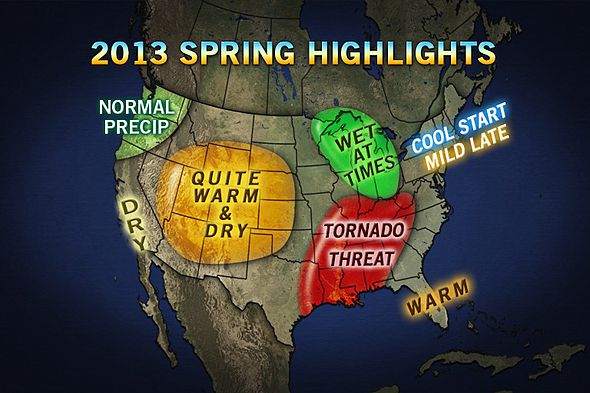AccuWeather issues a spring outlook for the U.S. every year, focusing on the major highlights of the season. AccuWeather’s Long-Range Forecasting Team is predicting that winter will hold on the longest, into March, across the Northeast and Northwest.

A near-normal tornado threat may be in store this spring, especially across the Mississippi and Tennessee valleys.
Another warm spring is expected across the Plains and Rockies, with worsening drought conditions across the hardest-hit areas. Extreme and exceptional drought conditions are gripping Colorado, Wyoming, South Dakota, Nebraska, Kansas, Oklahoma and portions of Texas.
More Winter, Late-Season Snowstorms
Winter may stick around for six more weeks across the Northeast and Northwest, no matter what prognostication Punxsutawney Phil makes on Groundhog Day.
“I think we could still see some late-season winter storms [in the Northeast],” AccuWeather Lead Long-Range Forecaster Paul Pastelok said.
A couple of winter storms may impact the Northeast during February and March. The potential exists for snow along the I-95 corridor from Washington, D.C., to New York City and Boston. This is not unusual for the region, as Pastelok noted, “Typically, February to March is the season on the East Coast.” Historically, some large winter storms such as the Blizzard of ’93 have struck the East Coast during March.
Snowfall will not be accompanied by the arctic cold that has been gripping the region this January, but more seasonable cold is predicted. Temperatures may be near to slightly below normal in the Northeast during February and March. While the spring will start out cooler and unsettled in the Northeast, milder weather may arrive by April and May.
Meanwhile, AccuWeather long-range meteorologists predict a return to a stormier pattern in the Northwest similar to early in December. Snowfall could impact travel through the heavily traveled mountain passes of the Northwest such as Snoqualmie Pass along I-90 in Washington, while rain dampens the I-5 corridor from Seattle to Portland.
Tornado Threat Returns
The number of tornadoes is predicted to be near-normal this spring. The average number of tornadoes per year in the U.S. is around 1,300, according to the Storm Prediction Center. Typically, April and May have the highest occurrence of tornadoes.
“Severe weather season this year will be different from last year,” Pastelok said. “I think it is going to be a more typical start. Late March into April we’ll get going, especially over the lower Mississippi and Tennessee valleys. But not like last year where we started very early in the season.” Last year, unusual warmth during the winter allowed a quick start to the severe weather season during January and February.
Arkansas, Missouri, Tennessee and Mississippi are among the states that will be in the battlegrounds for severe storms this spring. Later in the season, severe storms may reach the Ohio Valley at times, including Kentucky and southern portions of Ohio, Indiana and Illinois. Cincinnati and Evansville, Ind., will be among the cities at risk later in the season.
Spring Warmth Still Strong, Not as Widespread as Last Year
The AccuWeather Long-Range Forecasting Team believes this spring could rank in the top-ten warmest for the U.S. again; however, the warmth will not be as widespread or as extreme as last year.
“The core of warmth for the spring is going to center itself in the dry areas, the western Plains, east-central Rockies, maybe extending down into the Southwest mid- to late-season,” Pastelok said.
Drought to Worsen for Hardest-Hit Areas
Drought conditions may worsen across portions of the Plains and Rockies this spring.
“Unfortunately for the western Plains and eastern Rockies, I think the drought is going to persist, and it is going to be strong going into the springtime,” Pastelok said. “In the heart of the drought, it doesn’t look good right now.”
With dry and warm weather persisting, the stage will be set for dangerous fire conditions by the summer.
“This could be devastating, especially for people in the agriculture industry,” AccuWeather Long-Range Meteorologist Mark Paquette said.
Farther north, beneficial rain may fall during April across portions of the Upper Midwest, including Iowa, Illinois and Minnesota. Some improvement with the Mississippi River flow is possible, but a full turn-around of the situation is not anticipated, according to Pastelok.
Source: AccuWeather.com
Was this article valuable?
Here are more articles you may enjoy.

 Self-Driving Startup Nuro Raises $106 Million at Lower Valuation
Self-Driving Startup Nuro Raises $106 Million at Lower Valuation  Roof Repair and Replacement Costs up Nearly 30% Since 2022, Report Shows
Roof Repair and Replacement Costs up Nearly 30% Since 2022, Report Shows  Plane Carrying New York Lawmakers Clipped at Reagan Airport
Plane Carrying New York Lawmakers Clipped at Reagan Airport  In Fight Over Insurance, Neighbors Crowdsource LA Fire Contamination Data
In Fight Over Insurance, Neighbors Crowdsource LA Fire Contamination Data 